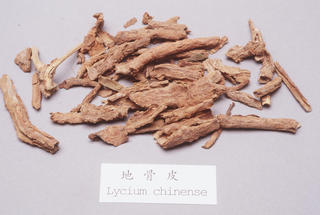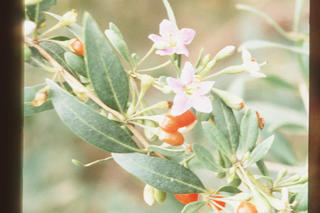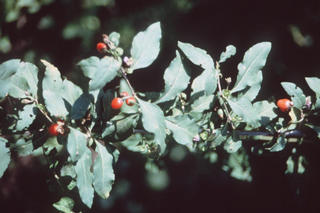Lycium chinense
Contents
- 1 Nomenclature
- 2 Historical Use of Lycium chinense
- 3 Background
- 4 Nomenclature
- 5 Historical Use of Lycium chinense
- 6 Background
- 7 Nomenclature
- 8 Historical Use of Lycium chinense
- 9 Background
- 10 Nomenclature
- 11 Historical Use of Lycium chinense
- 12 Background
- 13 Pharmaceutical Information
- 14 Evidence or the Use of Lycium chinense in the Treatment of Epilepesy
- 15 Safety
Nomenclature
Other Names:
Historical Use of Lycium chinense
Lycium chinense in Traditional Chinese Medicine
Background
Chinese Name (pinyin): Digupi
Chinese Name :
Common Name :Wolfberry Bark
Specific Name : Cortex lycii
Scientific Name:
Collection : The root is collected in early spring or late autumn and wash clean, then the root bark is stripped and dried in the sun.
Description : Quilled or channeled, 3-10cm long, 0.5-1.5 cm wide, 1-3mm thick, outer surface greyish yellow to brownish-yellow, rough with irregular longitudinal fissures, easily exfoliated. Inner surface yellowish white to greyish yellow, relatively even with fine longitudinal wrinkles. Texture light and fragile, easily broken, fracture uneven, outer layers yellowish brown and inner layers greyish white. Odour slight, taste sweetish and then bitter.
Identification : Transverse section: cork consisting of 4-10 or more rows of cells thicker rhytidome present. Most phloem rays 1 row of cells wide, fibres slghtly scattered or 2 to several bundles. Parenchymatous cells containing sand crystals of calcium oxalate and numerous starch granules.Total Ash: Not more than 11.0%
Processing : Eliminate foreign matter and remains of wood, wash clean and dry in the sun.
Action : To reduce heat in blood, to relieve consumptive fever, and to remove heat from the lung.
Indication : afternoon fever and night sweat in consumptive diseases; cough, hemoptysis and epistaxis due to heat in the lung; diabetes caused by internal heat
Precautions :
Dosage : 9 to 15 g.
Storage : Preserve in a dry place.
Nomenclature
Other Names:
Historical Use of Lycium chinense
Lycium chinense in Traditional Chinese Medicine
Background
Gangouqi ¸ÊèÛè½
Gouqi èÛè½
Chinese Name (pinyin): Gouqizi
Chinese Name :
Common Name :Wolfberry Fruit
Specific Name : Fructus lycii
Scientific Name:
Collection : The drug is collected in autumn and summer when the fruit turns orange red. After drying in the shade to make the pericarp shrunken, the drug is exposed to strong sun light until the exocarp is dried, hard and the pulp soft, remove from fruit stalk.
Description : Subfusiform, slightly flattened, 6 - 21mm long, 3 - 10mm in diameter. Externally scarlet or dark red, marked with protrudent style scar at the apex and a white fruit stalk scar at the base. Pericarp pliable and shrunken, sarcocarp fleshy, soft and viscous, seeds numerous, flat and subreniform. 1.5 - 1.9mm long, 1 - 1.7mm wide, pale yellow or brownish yellow on surface, odourless, taste sweet and slightly sour.Foreign matter: not more than 1%
Identification :
Processing :
Action : To benefit the liver and the kidney, to replenish vital essence and to improve eyesight.
Indication : general debility with deficiency of vital essence manifested by achich of the loins and knees, dizziness and tinnitus; diabetes caused by internal heat; anemia; impaired vision
Precautions :
Dosage : 6 to 12 g.
Storage : Preserve in a cool and dry place, protected from heat, moisture and moth.
Nomenclature
Other Names:
Historical Use of Lycium chinense
Lycium chinense in Traditional Chinese Medicine
Background
Chinese Name (pinyin): Digupi
Chinese Name :
Common Name :Wolfberry Bark
Specific Name : Cortex lycii
Scientific Name:
Collection : The root is collected in early spring or late autumn and wash clean, then the root bark is stripped and dried in the sun.
Description : Quilled or channeled, 3-10cm long, 0.5-1.5 cm wide, 1-3mm thick, outer surface greyish yellow to brownish-yellow, rough with irregular longitudinal fissures, easily exfoliated. Inner surface yellowish white to greyish yellow, relatively even with fine longitudinal wrinkles. Texture light and fragile, easily broken, fracture uneven, outer layers yellowish brown and inner layers greyish white. Odour slight, taste sweetish and then bitter.
Identification : Transverse section: cork consisting of 4-10 or more rows of cells thicker rhytidome present. Most phloem rays 1 row of cells wide, fibres slghtly scattered or 2 to several bundles. Parenchymatous cells containing sand crystals of calcium oxalate and numerous starch granules.Total Ash: Not more than 11.0%
Processing : Eliminate foreign matter and remains of wood, wash clean and dry in the sun.
Action : To reduce heat in blood, to relieve consumptive fever, and to remove heat from the lung.
Indication : afternoon fever and night sweat in consumptive diseases; cough, hemoptysis and epistaxis due to heat in the lung; diabetes caused by internal heat
Precautions :
Dosage : 9 to 15 g.
Storage : Preserve in a dry place.
Nomenclature
Other Names:
Historical Use of Lycium chinense
Lycium chinense in Traditional Chinese Medicine
Background
Gangouqi ¸ÊèÛè½
Gouqi èÛè½
Chinese Name (pinyin): Gouqizi
Chinese Name :
Common Name :Wolfberry Fruit
Specific Name : Fructus lycii
Scientific Name:
Collection : The drug is collected in autumn and summer when the fruit turns orange red. After drying in the shade to make the pericarp shrunken, the drug is exposed to strong sun light until the exocarp is dried, hard and the pulp soft, remove from fruit stalk.
Description : Subfusiform, slightly flattened, 6 - 21mm long, 3 - 10mm in diameter. Externally scarlet or dark red, marked with protrudent style scar at the apex and a white fruit stalk scar at the base. Pericarp pliable and shrunken, sarcocarp fleshy, soft and viscous, seeds numerous, flat and subreniform. 1.5 - 1.9mm long, 1 - 1.7mm wide, pale yellow or brownish yellow on surface, odourless, taste sweet and slightly sour.Foreign matter: not more than 1%
Identification :
Processing :
Action : To benefit the liver and the kidney, to replenish vital essence and to improve eyesight.
Indication : general debility with deficiency of vital essence manifested by achich of the loins and knees, dizziness and tinnitus; diabetes caused by internal heat; anemia; impaired vision
Precautions :
Dosage : 6 to 12 g.
Storage : Preserve in a cool and dry place, protected from heat, moisture and moth.
Synonymns for Lycium chinense
Patent Medicines and Medicines with Multiple Ingredients that include Lycium chinense
Pharmaceutical Information
Chemical Constituents
Evidence or the Use of Lycium chinense in the Treatment of Epilepesy
Basic Science
Animal Studies
Cohort, Case-Control and Non-Randomized Trials
Randomized Controlled Trials
Meta-Analysis
1st Five Results: pubmed search
Hyeyoun Ryu, Minji Ryu, Eun Jin Jeon, Young Ju Park, Byeongsam Kang, Yoshitaka Ono, Ok-Kyung Kim, Seong-Jin Lee
##Title##
Plant Dis: 2024;
[PubMed:38640430]
[WorldCat.org]
[DOI]
(P a)
Xuewen Jia, Hongyan Yu, Biao Du, Yubang Shen, Lang Gui, Xiaoyan Xu, Jiale Li
Incorporating Lycium barbarum residue in diet boosts survival, growth, and liver health in juvenile grass carp (Ctenopharyngodon idellus).
Fish Shellfish Immunol: 2024;109573
[PubMed:38636742]
[WorldCat.org]
[DOI]
(I a)
Tao Wang, Huan Liao, Jinghan Lin, Mingkai Zhang, Baosong Chen, Ruopeng Yin, Jingzu Sun, Huanqin Dai, Hongwei Liu
Antidiabetic action of the Chinese formula Shouhuitongbian and the underlying mechanism associated with alteration of gut microbiota.
Phytomedicine: 2024, 129;155575
[PubMed:38636179]
[WorldCat.org]
[DOI]
(I a)
Bo Zhang, Wangsuo Liu, Xueli Ding, Wei Zhang, Jinzhong Zhu, Xuejun Wang
##Title##
Mitochondrial DNA B Resour: 2024, 9(4);517-521
[PubMed:38628907]
[WorldCat.org]
[DOI]
(I e)
Meng Zhang, Hui Li, Tingting Tan, Lu Lu, Jia Mi, Abdul Rehman, Yamei Yan, Linwu Ran
##Title##
Food Sci Nutr: 2024, 12(4);2379-2392
[PubMed:38628207]
[WorldCat.org]
[DOI]
(P e)


